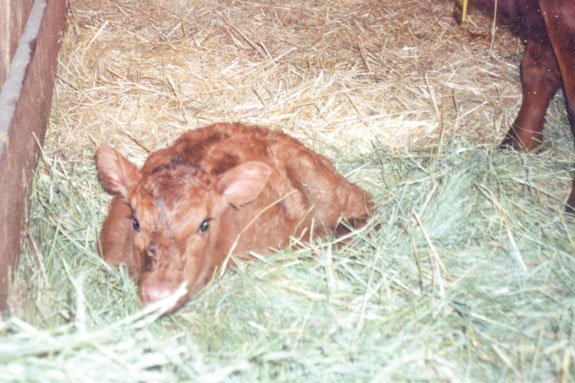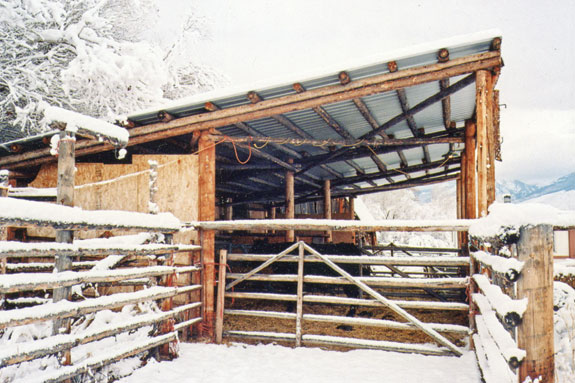In some situations it may be a simple shed with room for two or three cows – just the ones that need assistance. In other climates you need room for as many cows as might be calving during any 24-hour period.
Shannon Williams, a county extension agent at the University of Idaho, says barns must be easy to thoroughly clean. “If you plan on using a four-wheeler with a blade on the front, or tractor and blade, are all your gates wide enough?”
“Rodger Swanson’s barn at the Maybe Ranch is a beautiful example. All his panels and gates are the same length, and can all be opened up, to run a tractor down through all the stalls,” says Williams.
Accessibility
Design the surrounding pens so one person can easily get a cow in and out of the barn. A well-planned system of gates and alleys eliminates the need for extra people, or chasing – making it easy on the cow and the person getting her in.
If there are several people on your calving crew, have a designated place for notes about cows in the barn. This is helpful when there’s change of shift between the night calver and the next person. “Whether you post notes on each stall, or in the warming room, your system must be functional and easy to use,” says Williams.
“It’s nice to have a place where people can come in and get warm, but not so comfortable they fall asleep. A chair with a cushion is good, but you might not want the La-Z-Boy recliner, nor have it so warm that the night calver dozes off,” she says.
You need good lighting in each stall, to easily see what’s going on. “You also need one stall or place in the barn with a headcatch – to check a cow or pull a calf,” says Williams. The calving stall or headcatch should be located for easy access from any stall. The headcatch should be designed so that if a cow goes down, you can quickly release her so she can lie flat if she needs to.

Safety
Williams reminds that whatever you use for partitions, make sure a person can get out. If a cow got somebody down in the stall, there should be room to roll under the panel. “I have a good friend who got knocked down and tromped in a stall, and couldn’t get out – and no one found him until the next shift came. He survived, but was seriously injured,” she says.
If the back wall is solid, put some rails there so a person could climb up if need be, or roll under them, to get away from an aggressive cow.
You may want space under each partition or at the back wall where a calf could be pushed under it and not be smashed by a confused or aggressive heifer. You don’t want the calf pushed into the next pen, but you need a space under the bottom rail. If you have to tag a new calf or disinfect the navel – and the cow is on the fight – you can safely handle the calf by dragging it under the panel instead of going into that stall.
“Think about the barn doors and how to keep them free of ice and manure so they swing or slide freely. If a door is under the eaves, you may get ice on the sliding door track.” Snow coming off the roof may dump a big pile in front of the doors. Design the barn so you can get in and out without having to shovel snow or manure or break loose frozen piles with a bar.
Build on a well-drained area so you’ll never have flooding during a thaw or wet weather. Don’t build where groundwater may settle in the spring. Any shelter area must be high and dry.

Calf shelters
During windy or wet weather, portable shelters can keep calves from being chilled and stressed. Dr. Ron Skinner, a veterinarian and seedstock producer near Hall, Montana, made skids and crosspieces for his durable calf hutches from 6-inch well casing, purchased from a salvage business, welded together.
“We can push or drag these shelters anywhere and they won’t break. We used vertical metal pieces and framed it with angle iron, bolted boards to that, and put a metal roof on,” he said.
He used plywood for the sides, painted for weather-proofing. The metal framework makes them durable. “The ones my dad had in the 1960s, we kept breaking the 6-by-6 boards when dragging them around,” says Skinner.
His hutches don’t have floors, so there’s no buildup of contamination inside. If it starts to get dirty, he moves the building with his tractor to a new location when feeding cows. “The tractor I handle round bales with has two forks on the loader and I can slide those under the end of the hutch, pick it up a little and slide it in any direction. We roll a little straw off a round bale right into it, for new bedding,” said Skinner.
Some lightweight open-sided shelters have a bar across the top so they can be picked up with a loader and moved. “You can put straw down first, then sit the shelter on the straw, and later move it to a different location. Place shelters so the open side is away from the wind,” he said.
The most important thing is keeping them clean. Since calves congregate there, you don’t want scours spreading through the group. “If you move sheds often, you leave the mess behind. Otherwise, they can become funeral homes instead of shelters,” he said.
“One side of a calf shelter should be open completely, to allow warm air to get out. Then calves aren’t just re-circulating aerosol droplets from each other’s breathing. I’ve seen enclosed shelters with one small door, and these create a lot of re-circulated air – and may allow some viruses and mycoplasma to become a problem,” explains Skinner.
The main thing is to always have clean, dry bedding and situate shelters out of the wind. “They need to face away from prevailing wind, hopefully to the south so the morning sun shines in. An open-sided calf shelter must have a lot of weight at the bottom or the wind may blow it over,” he said. ![]()
PHOTOS
TOP: A portable calf shelter is not only durable against the elements but can be moved with its strong framing.
MIDDLE: For safety reasons a calving shed should have rails like this one, so someone can safely climb out.
BOTTOM: This open-front calving shed with six stalls is supported by wooden posts and a durable tilt roof.
Designs for a simple facility
Oregon State University published a Calving School Handbook (by Bill Zollinger, Department of Animal Science, and Don Hansen, College of Vet Medicine) that includes a simple design for a headcatch and a floor design for a calving shed, utilizing gates and easy ways to move animals in and out.
A concrete pad or well-drained floor is important for the headcatch area, so it won’t become muddy or slippery and can be easily cleaned. Rough concrete gives traction and can be swept or hosed clean (if a floor drain is installed).
Otherwise, a sandy floor with straw on top can provide cleanliness and cushion. In many instances you’ll want the cow lying down for pulling a calf, after you’ve corrected any malpresentation. Straw can be cleaned out and replaced after every assisted birth.
Hinged, swing-away gates can be mounted on each side of the headcatcher to create a “chute” to hold the cow while you check her or begin to assist birth. Then the gates can be swung away so she can lie down if she needs to. The headcatcher should be designed with straight sides opening all the way to the floor so it won’t bind the animal’s head/neck if she lies down. The OSU booklet describes how to make a simple outdoor or indoor calving assistance area with minimal expense.
For an operation that doesn’t need a large barn, a portable calving shed can be moved to whatever pasture you need it. You may not want permanent calving facilities, calving on new, clean ground each year.
The Canada Agriculture Research Station at Melfort, Saskatchewan, published a design for a portable shed created with welded pipe for the frame (2.5-inch steel pipe or 2.25-inch drill stem pipe). Skids can be made from 2-by-8 lumber, logs, or rough-cut lumber, with 2-by-6’s for the uprights.
The portable shed can have two or three stalls, each with a built-in pipe frame headcatch (dairy stanchion style) and crowding gate to put the cow into the headcatch. A heat lamp can be situated in the corner of each stall, if desired, behind a protective barrier so it can’t be bumped by cow or calf. Propane heaters can be used if there’s no electricity available.
Doors are two pieces. The top part of the door to each stall can be swung up and latched open in mild weather to let in sunshine. The bottom can be latched open when stalls are no longer needed for calving, allowing calves to enter for shelter. If a person wants an actual “barn,” two of these portable sheds can be situated face to face to make a small barn with an alleyway between the two sides. These sheds can be moved anywhere, to provide clean, sheltered calving stalls wherever needed.







